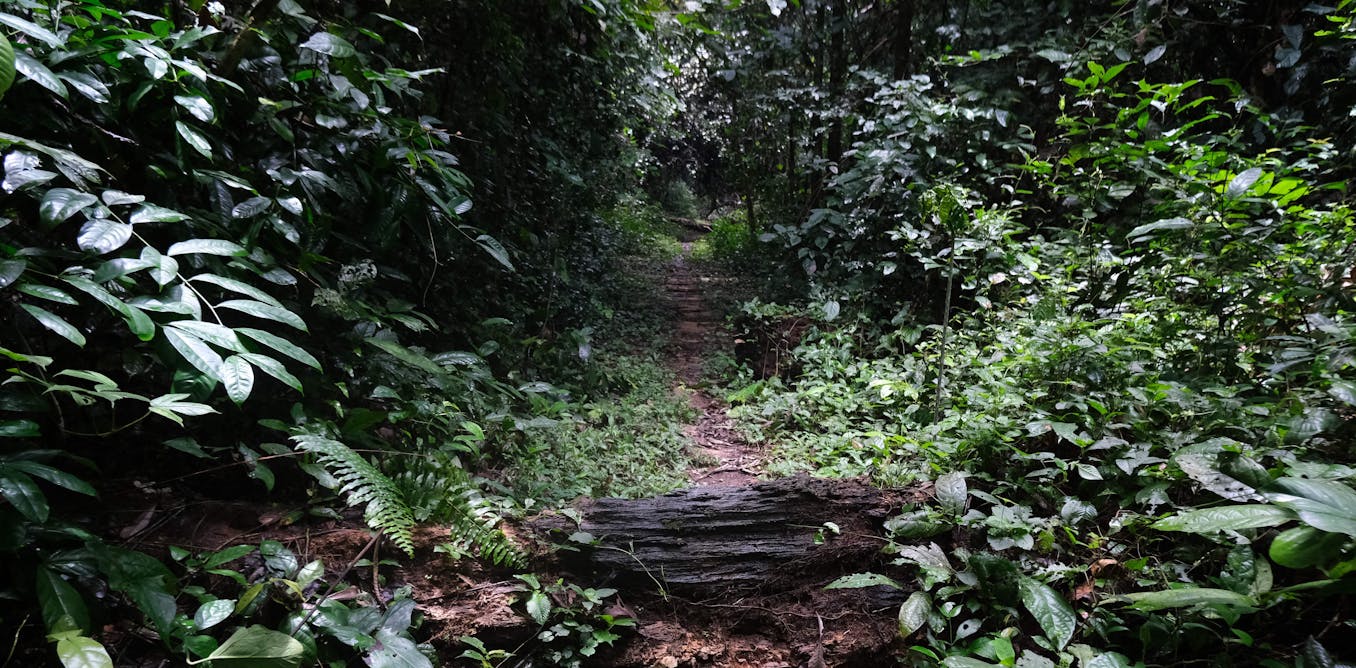Nigeria’s forest cover has been dwindling fast for decades. With one of the highest rates of deforestation in the world, there are concerns about the survival of its forest resources. We asked forest management and biodiversity conservation expert Amusa Tajudeen to explain why the country’s forests are disappearing and what to do about it.
Which parts of Nigeria are covered by forest?
Nigeria has a rain forest zone in the south. Forest cover decreases in density towards the north, where the savannah belt is characterised by grasses and sparse tree cover. The rain forest ecosystem lies between latitudes 4⁰N and 9⁰N and extends from the coast to about 250km inland.
What is the current status of Nigeria’s forest cover?
Nigeria’s forest cover is diminishing in extent and quality. But reliable data is scarce. For instance, one record indicates that Nigeria’s land mass is 910,770km² and forest occupies 110,890km², or 12.8% of the total land mass. Another shows that Nigeria’s land mass is 997,936km² and only 10% is under forest reserve.
At independence in 1960, it was reported that the colonial government had set aside 97,000km² (9.72%) of the country as forest reserves.
Historical accounts also indicate that the country’s rain forest, which was over 600,000km² in 1897 (60% of land mass), had reduced by about half in 1960 to 30% of land mass.
Nigeria’s forests covered an estimated 175,000km² in 1990 and 135,000km² in 2000. Between 2000 and 2004, the country was said to have lost 55.7% of its primary forests – that is, 75,195km² of native and original forests that have never been logged and have developed under natural processes.
A report by the United Nations Collaborative Programme on Reducing Emissions from Deforestation and Forest Degradation in Developing Countries (UN-REDD) shows that the decline rate of forest cover in Nigeria ranged from 3.5% to 3.7% per annum over the period 2000 to 2010. This translates to a loss of 350,000–400,000 hectares of forest land yearly.
Unless something decisive is done, and urgently, the country will lose all its forest areas by the year 2052, if the prevailing rate of deforestation at 3.5% annually is anything to go by.
Why is forest cover important?
Forests are very important for the economic development of every nation. They also have environmental, ecological, socio-cultural, scientific and research service functions.
Forests provide numerous goods and services. Some are needed as raw materials – for example wood for building materials, fuel and paper.
Forests also offer natural foods and non-timber products like oilseeds, latexes, gums, resins, rattan, vanilla and game. Forest-based industries such as sawmills, paper mills and furniture industries provide employment and income.
Forest ecosystems offer physical, biological and chemical benefits. These include:
conserving soil, controlling the timing and volume of water flows, protecting water quality and maintaining aquatic habitats
preventing disasters like floods and landslides, and moderating winds
conserving biodiversity
storing carbon, which mitigates climate change.
The socio-cultural service functions of forests cover nature-based tourism and ecotourism activities. Ecotourism provides a means for people to use the forest without extracting its resources or degrading the environment. Wildlife attracts many visitors and foreign exchange earnings.
In addition, forests help to deepen our understanding of the natural world. Through research, we learn new things about species, habitats and ecosystems. Forest resources are particularly important in medicine, including immunology and other studies of diseases.
Why is Nigeria’s forest cover being depleted?
Before the 1950s, the forestry and agriculture sectors contributed over 80% of Nigeria’s gross domestic product. This changed after the discovery of oil in the 1950s and early 1960s.
Today, the laws and policies associated with forest administration are obsolete. In addition, supervision, monitoring and surveillance of forest areas is poor. Staffing and provision of basic infrastructure are grossly inadequate.
The principle of sustained yield forestry, when products removed from the forest are replaced by growth, has been abandoned in most forest reserves. Inventory records of resources are insufficient. Local people don’t participate enough in decision-making related to forests. The forestry sector is also affected by corruption, such as misappropriation of funds and illegal activities.
In Nigeria, primary forests are cleared extensively. The various state forestry departments have been unable to adequately protect the forest estate. Most forest reserves that were once managed for timber production have become deforested and fragmented. Many have been converted for other land uses.
Large scale agriculture has consumed a significant portion of forested areas. Similarly, unlawful and indiscriminate logging activities take place in naturally occurring forests.
Urbanisation, which comes with roads, buildings and other infrastructure, is often carried out without proper planning.
How can this depletion be tackled?
Based on our studies of the Nigerian forests over the years and lessons from numerous projects carried out, I have the following recommendations:
Most countries have a forestry law. Unfortunately Nigeria’s forest policy is not backed by a code or act. A national Forestry Act could reverse the decline in forest cover. It could give adequate protection and ensure sustainable management of the country’s forest estate.
There is an urgent need to plant and replant trees across the country. The various state governments can collaborate with non-governmental organisations to achieve this.
Reforestation involves replanting trees in areas where forests have been destroyed. Afforestation involves creating new forests on previously non-forested land. These campaigns should plant a diverse range of native tree species.
It’s also crucial to promote sustainable forestry practices. The government should enforce strict regulations against illegal logging and unsustainable timber harvesting. Enforcement can be done using technology such as remote sensors, drones and satellite imagery. It is essential to work with local communities, traditional leaders and NGOs to raise awareness about the importance of forest conservation.
Finally, there should be proper staffing. Adequately trained forest professionals and well equipped guards should be hired to safeguard the forests. Education and training programmes should teach local communities, forest workers and farmers about sustainable forestry methods and the importance of preserving biodiversity.




